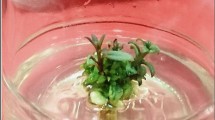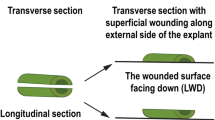Abstract
Jatropha curcas is an oil bearing species with multiple uses and considerable economic potential as a biofuel plant, however, oil and deoiled cake are toxic. A non-toxic variety of J. curcas is reported from Mexico. The present investigation explores the effects of different plant growth regulators (PGRs) viz. 6-benzyl aminopurine (BAP) or thidiazuron (TDZ) individually and in combination with indole-3-butyric acid (IBA), on regeneration from in vitro and field-grown mature leaf explants, in vitro and glasshouse-grown seedlings cotyledonary leaf explants of non-toxic J. curcas. In all the tested parameters maximum regeneration efficiency (81.07%) and the number of shoot buds per explants (20.17) was observed on 9.08 μM TDZ containing Murashige and Skoog’s (MS) medium from in vitro cotyledonary leaf explants. The regenerated shoot buds were transferred to MS medium containing 10 μM kinetin (Kn), 4.5 μM BAP and 5.5 μM α-naphthaleneacetic acid (NAA) for shoot proliferation. The proliferated shoots could be elongated on MS medium supplemented with 2.25 μM BAP and 8.5 μM IAA. Rooting was achieved when the basal cut end of elongated shoots were dipped in half strength MS liquid medium containing different concentrations and combinations of IBA, IAA and NAA for four days followed by transfer to growth regulators free half strength MS medium supplemented 0.25 mg/l activated charcoal. The rooted plants could be established in soil with more than 90% survival rate.

Similar content being viewed by others
Abbreviations
- BAP:
-
6-Benzylaminopurine
- IAA:
-
Indole-3-acetic acid
- IBA:
-
Indole-3-butyric acid
- Kn:
-
Kinetin
- MS:
-
Murashige and Skoog
- NAA:
-
Naphthaleneacetic acid
- TDZ:
-
Thidiazuron
References
Azad MAK, Yokota S, Ohkubo T, Andoh Y, Yahara S, Yoshizawa N (2005) In vitro regeneration of the medicinal woody plant Phellodendron amurense Rupr. Through excised leaves. Plant Cell Tissue Organ Cult 80:43–50
Christopher T, Rajam MV (1996) Effect of genotype, explant and medium on in vitro regeneration of red pepper. Plant Cell Tissue Organ Cult 46:245–250
da Camara Machado A, Frick NS, Kremen R, Katinger H, da Camara Machado ML (1997) Biotechnological approaches to the improvement of Jatropha curcas. In Proceedings of the International Symposium on Jatropha,. Managua, Nicaragua, Mexico, pp. 15
Deore AC, Johnson TS (2008) High-frequency plant regeneration from leaf-disc cultures of Jatropha curcas L.: an important biodiesel plant. Plant Biotech Rep 2:10–15
Feyissa T, Welander M, Negash L (2005) In vitro regeneration of Hagenia abyssinica (Bruce) J.F. Gmel. (Rosaceae) from leaf explants. Plant Cell Rep 24:392–400
Huetteman CA, Preece JE (1993) Thidiazuron: a potent cytokinin for woody plant tissue culture. Plant Cell Tissue Organ Cult 33:105–119
Hyde CL, Phillips GC (1996) Silvernitrate promotes shootdevelopment and plant regeneration of Chilepepper (Capsicum annuum L.) via organogenesis. In Vitro Cell Dev Biol Plant 32:72–80
Jha T, Mukherjee P, Datta MM (2007) Somatic embryogenesis in Jatropha curcas Linn. an important biofuel plant. Plant Biotech Rep 1:135–140
Kaminek M (1992) Progress in cytokinin research. Trends Biotech 10:159–162
Kumar N (2008) Studies on regeneration and genetic transformation of Jatropha curcus. Phd Thesis, Bhavnagar University, Bhavnagar, India
Kumar N, Reddy MP (2010) Plant regeneration through the direct induction of shoot buds from petiole explants of Jatropha curcas: a biofuel plant. Ann Appl Biol 156:367–375
Kumar N, Pamidimarri SDVN, Kaur M, Boricha M, Reddy MP (2008) Effects of NaCl on growth, ion accumulation, protein, proline contents, and antioxidant enzymes activity in callus cultures of Jatropha curcas. Biologia 63:378–382
Kumar N, Vijayanand KG, Reddy MP (2010a) Shoot regeneration from cotyledonary leaf explants of Jatropha curcas: a biodesel plant. Acta Physiol Plant 32:917–924
Kumar N, Vijayanand KG, Reddy MP (2010b) In vitro plant regeneration of non-toxic Jatropha curcas L: direct shoot organogenesis from cotyledonary petiole explants. J Crop Sci Biotech 13:189–194
Kumar N, Vijayanand KG, Pamidimarri DVNS, Sarkar T, Reddy MP, Radhakrishnan T, Kaul T, Reddy MK, Sapori SK (2010c) Stable genetic transformation of Jatropha curcas via Agrobacterium tumefaciens-mediated gene transfer using leaf explants. Ind Crop Prod 32:41–47
Kumar N, Vijayanand KG, Reddy MP (2011) In vitro regeneration from petiole explants of non-toxic Jatropha curcas. Ind Crops Prod 33:146–151
Makkar HPS, Becker K (1997) Potential of Jatropha seed cake as protein supplement in livestock feed and constraints to its utilization. In Proceedings of Jatropha: International symposium on Biofueland Industrial Products from Jatropha curcas and otherTropical Oil Seed Plants. Nicaragua, Mexico, pp. 23–27
Makkar HPS, Aderibigbe AO, Becker K (1998) Comparative evaluation of non-toxic and toxic varieties of Jatropha curcas for chemical composition, digestibility, protein degradability and toxic factors. Food Chem 62:207–215
Martin KP (2003) Rapid axillary bud Proliferation and ex vitro rooting of Eupatorium triplinerve. Biol Plant 47:589–591
Misra P, Gupta N, Toppo DD, Pandey V, Mishra MK, Tuli R (2010) Establishment of long-term proliferating shoot cultures of elite Jatropha curcas L. by controlling endophytic bacterial contamination. Plant Cell Tissue Organ Cult 100:189–197
Murashige T, Skoog F (1962) A revised medium for rapid growth and bioassays with tobacco tissue cultures. Physiol Plant 15:473–479
Nielsen JM, Kirsten B, Hansen J (1993) Long-term effects of thidiazuron are intermediate between Benzyladenine, kinetin or isopentenyladenine in Miscanthus sinensis. Plant Cell Tissue Organ Cult 35:173–179
Ozaslan M, Can C, Aytekin T (2005) Effect of explant source on in vitro propagation of Paulownia tomentosa Steud. Biotech Biotech Equip 19:20–26
Preece JE, Imel MR (1991) Plant regeneration from leaf explants of Rhododendron ‘P.J.M. Hybrids’. Sci Hort 48:159–170
Raghu AV, Geetha SP, Martin G, Balachandran I, Ravindran PN (2006) Direct organogenesis from leaf explants of Embelia ribes Burm. -a vulnerable medicinal plant. J For Res 11:57–60
Rajore S, Batra A (2007) An alternative source for regenerable organogenic callus induction in Jatropha curcas. Indian J Biotechnol 6:545–548
Reddy MP, Kumar N, Vijayanand KG, Singh AH, Singh S (2008) Method for micropropagation of Jatropha curcas plants from leaf explants. (Patent filed US and PCT, File No.0088NF2008).
Shen X, Kane ME, Chen J (2008) Effects of genotype, explants source, and plant growth regulators on indirect shoot organogenesis in Dieffenbachia cultivars. In Vitro Cell Dev Bio Plant 44:282–288
Singh A, Reddy MP, Patolia JS (2008) An improved protocol for micropropagation of elite genotypes of Simmondsia chinensis (Link) Schneider. Biol Plant 52:538–540
Sujatha M, Mukta N (1996) Morphogenesis and plant regeneration from tissue cultures of Jatropha curcas. Plant Cell Tissue Organ Cult 44:135–141
Sujatha M, Makkar HPS, Becker K (2005) Shoot bud proliferation from axillary nodes and leaf sections of non-toxic Jatropha curcas L. Plant Growth Regul 47:83–90
Takeda Y (1982) Development study on Jatropha curcas (sabudum) oil as a substitute for diesel engine oil in Thailand. J Agr Assoc China 120:1–8
Venkataiah P, Subhash K (2003) Thidiazuron-induced adventitious shoot bud formation and plant regeneration in Capsicum annuum L. J Plant Biotechnol 5:245–250
Acknowledgements
The authors gratefully acknowledge Council of Scientific and Industrial Research, New Delhi for financial assistance and Prof. K. Becker, Department of Aquaculture Systems and Animal Nutrition, University of Hohenheim, Stuttgart, Germany for providing Mexican non-toxic J. curcas seeds. Statistical data analysis support from Dr. Keyur Shah and Dr. Amritpal Singh, Assistant professor, Anand Agricultural University, Anand is thankfully acknowledged.
Author information
Authors and Affiliations
Corresponding author
Rights and permissions
About this article
Cite this article
Kumar, N., Vijay Anand, K.G. & Reddy, M.P. Plant regeneration of non-toxic Jatropha curcas—impacts of plant growth regulators, source and type of explants. J. Plant Biochem. Biotechnol. 20, 125–133 (2011). https://doi.org/10.1007/s13562-011-0037-6
Received:
Accepted:
Published:
Issue Date:
DOI: https://doi.org/10.1007/s13562-011-0037-6




